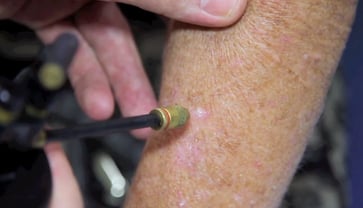Everything you need to know about cryotherapy for skin cancer
If you have been diagnosed with skin cancer, there are various surgical and non-surgical treatments available. Your doctor will consider the most appropriate therapy for your circumstances, and may recommend cryotherapy - a common treatment option for sunspots and superficial basal cell carcinomas. If you are preparing for this procedure, here is everything you need to know.
Cryotherapy is a freezing technique applied to benign and malignant lesions. It works by freezing and injuring the surface layer of skin so that normal skin healing can occur.
 During the procedure, liquid nitrogen is sprayed onto the lesion and a small area of surrounding tissue to ensure no abnormal cells are left behind. This causes a burning or stinging sensation which can last up to an hour following the procedure with moderate discomfort. Your skin will show signs very similar to sunburn.
During the procedure, liquid nitrogen is sprayed onto the lesion and a small area of surrounding tissue to ensure no abnormal cells are left behind. This causes a burning or stinging sensation which can last up to an hour following the procedure with moderate discomfort. Your skin will show signs very similar to sunburn.
The liquid nitrogen freezes and kills the abnormal skin cells and creates a wound, which may be swollen and red for a few days and form a blister. Blisters can become painful and uncomfortable, but you should try to avoid bursting them. If a blister bursts, keep it clean and apply a dry dressing.
The treated area does not need to be covered and you can shower as normal. Daily showers will help your wound heal faster, but you should avoid using soaps, creams and antiseptics as these will delay the healing process.
A scab will form after a few days and drop off after one to six weeks, depending on the area of the body. New, healthy skin cells will grow and a scar may develop. The healed skin will probably look paler and whiter than the surrounding skin. In some cases, the procedure may need to be repeated.
Contact your doctor if you are concerned that the site has become infected. You can identify a potential infection if the surrounding skin is becoming tender to touch; the redness is increasing and extends to more than 1cm from the treated area; the area is warm to touch; or the wound smells.
Click here to download more information on cryotherapy, or learn more about the different ways of treating skin cancer.
- Tags:
- Treatment
